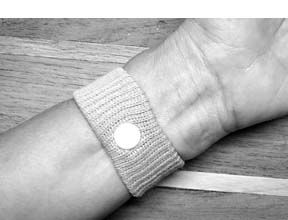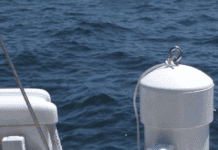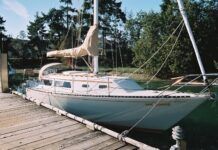It was back in 1995-96 that we last discussed seasickness in Practical Sailor. Reviewing the sometimes acrid letters and responses that flowed forth and back around the issue, we’ve reconfirmed our clear understanding that there’s no clear understanding on this issue, and we won’t be making any ironclad recommendations here.

There are different remedies that work for different people. At one end of the scale, there’s ginger in various forms from tablets to ale—very mild, and amazingly effective for generations of sailors. Some sailors, that is. At the other end there’s transdermal scopalamine, sold under the brand name Transderm Scop. It’s a circular flat patch that releases the drug into the skin. In some people it produces almost no side-effects beyond a bit of dry-mouth; in others it brings on a range of nasty effects up to and including hallicination.
Our colleague publication, Powerboat Reports, has a reader named Lee Beall, who has always suffered from mal de mer, and in fact gets motion-sick in almost any vehicle. He intrepidly volunteered to test a variety of off-the-shelf cures this past summer, and we at PS naturally watched with interest. Here’s the report:
What Was Tested
“I hold the record for the ‘strangest shade of green’ ever seen by the captain of the fishing boat we had chartered out of Southport, N C, so testing remedies is certainly in my best interest,” said Lee, who tried six products: three wrist bands (Sea-Band, BioBand and ReliefBand) and three orally taken remedies (Bonine, ginger tablets, and Dramamine).
Of the wristband products, ReliefBand by far is the most expensive at nearly $45. This battery-powered unit is also the most “high-tech” in appearance, design and action. (A second ReliefBand, called the Adventurer, sells for $150. It has replaceable 3V watch batteries, a leather strap, storage case, and claims to be water- and shock-resistant.) The other bands, which are similar in appearance and design, fit the wrist snugly and make use of a plastic button that is to be placed at the correct acupressure point. They sell for about $10. All three products are to be worn on the wrist, either continuously or whenever motion sickness symptoms strike.
The orally taken products were all about $5 per unit. We did not test the Transderm Scop system because it requires a prescription.
Test Procedures
The idea was to set aside one day to test each product. That way, if Lee got sick he would have the rest of the day to recover and get ready for the next sample. Lee tested the products in a car rather than on a boat, simply because it’s virtually impossible to reproduce on-the-water conditions for fair testing.
Any attempt by Lee to read while riding as a passenger in an automobile has always resulted in nausea and vomiting within an hour.
As directed by the instructions, Lee started wearing each bracelet 30 to 45 minutes before leaving the house. The pills required him to wait about an hour before getting in the car.
The car ride began with Lee in the front passenger seat with reading material in hand. He tried to concentrate on reading the magazine and talking with the driver as they traveled on a variety of roads—city streets, county roads, and state highways. The 70-mile route from Lee’s house to a nearby lake takes about 90 minutes. With its many curves and stop signs, it was anything but a smooth trip. Lee wrote the following account of his experiences with each product.
Sea-Band Wristband ($7)
This product uses an acupressure technique to help reduce nausea and other motion sickness symptoms. Sea-Band provides two non-adjustable elastic bands: Both must be worn—one on each wrist—for it to be effective. According to the product literature, the knob on the band is to be placed on the P6 Neiguan (or Nei-Kuan) point on each wrist, which is easily located using the enclosed diagram. The point is effectively three finger widths from the first wrist crease.
After 30 minutes on the road, I felt no symptoms of queasiness or nausea—and still nothing after another 30 minutes. I tried looking up at the road and back to the magazine for a few miles to see if that would spur some sickness. (Now that’s going above and beyond the call of duty.) It did not.
The product worked as advertised.
BioBand ($10)
This acupressure product requires you wear only one bracelet. The BioBand’s cloth band is easily adjusted with a Velcro-like strip. It was not as easy to concentrate on the reading material due to a stuffy feeling and a slight queasiness within the first 45 minutes on the road. It did not feel like motion sickness, though; I think something else, maybe a cold, was bothering me that day. Anyway, after the first hour, we stopped for a break but were back on the road after 20 minutes. By then, I was feeling much better and did not feel queasy for the remainder of the test. This product worked, but I can’t explain that unsettled feeling I had at the beginning of the drive.
ReliefBand ($45)
The ReliefBand, which comes with a 23-page instruction manual, is a very elaborate band device that looks like a proverbial Buck Rogers wristwatch. It comes with a tube of conductivity gel. The manual’s directions are very clear and straightforward. With its watchband-like bracelet, I found it easy to strap on. There’s no doubt if it’s working or not because it actually delivers a small electrical shock. The manual calls it a “tingling” sensation, but I got a distinct shocking sensation. Maybe this product works by threatening you into submission.

About 30 minutes before leaving the house, I put the ReliefBand on my left wrist according to the instructions. I did not think I was getting adequate “tingling,” so I removed it and applied the conductivity gel as directed. Even then, the tingling was weak and sporadic, so I applied more. Apparently, people tend to use too little of the gel. With the second application, the tingling was readily apparent. In fact, as I later found out, if I rested my arm on the car console there was a minor shocking sensation: nothing harmful, but you could definitely feel it.
Needless to say, you want the ReliefBand set at the lowest of the five settings that will still provide adequate results. I started at one, moved to two, and then to three—and then quickly back to two. The “two” setting was perfect for me. I did not even try settings four and five.
After nearly four hours of road testing I felt absolutely no sensations of queasiness or nausea. It was as if I was home reading in my recliner.
Bonine (meclizine hydrochloride)
I took two tablets an hour before the ride. By the time we started, I was already feeling drowsy (a side effect clearly labeled on the package). Within 20 minutes, I was feeling queasy and was yawning every few minutes. I had to call off the test after only an hour on the road. The queasy, nauseated feeling was too bad to continue without a barf bag in the car. A 20-minute break for a Coke and a snack had me feeling better, but we did not continue the test. As the day progressed, I got sleepier and sleepier. That night I slept like a rock. Bonine did not work for me.
Dramamine (dimenhydrinate)
The Dramamine worked perfectly. Two tablets were taken an hour before starting. There was no queasiness and only a slight bout of drowsiness. I experienced absolutely no symptoms of motion sickness. I didn’t try Dramamine II because its active ingredient is the same as Bonine’s—meclizine hydrochloride. I’m the guinea pig, but I’m not a stupid guinea pig.
Ginger Tablets
One ginger tablet was taken 20 minutes before we left. Twenty minutes into the trip, I had to call a halt to the test. I was totally nauseated and had to make a quick stop on the side of the road to walk around and get things settled. Ginger doesn’t work for me.
On-Water Test
Since the ReliefBand worked so well in the car, I wore it during a daytime deep-sea fishing trip for snapper in the Gulf of Mexico. It was on my wrist from 4 a.m. until 5 p.m., meaning I slipped on the band two hours before leaving the dock and removed it once the dock was in sight upon return. The product worked as advertised, but it is definitely not a total cure-all. Even though I did not get nauseated that day, I did not really feel well. I felt like I could become sick at any moment.
The normal setting of the ReliefBand used for motion sickness testing (in the car) was “2.” I started the day with the “2” setting and increased it to “3” as soon as we were out of sight of land. It remained on “3” until about 3 p.m. when the boat headed for the dock, at which time I changed the setting to “1.”
The shock was repeated all day, every 4 seconds. After about eight hours, the point on my wrist at which the shock was being administered was really sensitive. It felt raw, but of course it wasn’t. It’s just that I was really tired of the shocks. A lowering of the setting to “1” got rid of the irritation/aggravation.
Conclusion/Recommendations
Thanks to Lee Beall and Powerboat Reports. As we said at the beginning, we’re not going to make any firm recommendations here.

Clearly acupressure bands work for some people. Whether they work for physiological or psychological reasons doesn’t matter. They have no side effects, and they’re cheap. Ginger, in several of its various forms, works for others. Unfortunately, many still need to take more aggressive measures.
If seasickness is enough of problem that it handicaps your sailing, then it makes sense to put yourself through the same type of testing that Lee Beall did—try one remedy after another, in fair testing conditions, until you find somethingthat works.
We’d be interested in knowing what seasickness solution works best for you. If you have a minute, drop us an e-mail at [email protected] and let us know. We’ll do a mini-survey and publish what we find out.
Contacts— BioBands Distributors, Inc., 30 Waterside Plaza, New York, NY 10010; 800-BIO-BANDS; www.biobands.com. Davis Instruments, 3465 Diablo Ave., Hayward, CA 94545; 510/732-9229; www.davisnet.com. ReliefBand, Woodside Biomedical, Inc., Carlsbad, CA 92008; 760/804-6902; www.reliefband.com. Sea-Band, 15 Vernon Ave., Newport, RI 02840; 401/841-5900; www.sea-band.com.
Also With This Article
Click here to view “Green Gills: Causes and Preventions.”





































